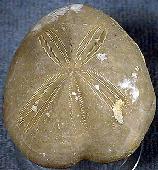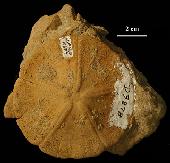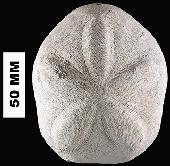|
 See More Images See More Images

Epiaster whitei
© 1998 Dr. Richard Paselk, Humboldt State University Natural History Museum

Astrodaspis coalingensis
© 2004 UCMP

Clypeaster rosaceus
© 2003 Roger Portell, Florida Museum of Natural History
|
What are Echinoids? Sand dollars, sea urchins, and heart urchins make up the group of echinoderms called echinoids. They have a rigid, round, oval, or heart-shaped skeleton, called a test, that is composed of tightly interlocking plates of calcium carbonate. Living echinoids are covered with spines, although the spines on sand dollars are short, giving the animal almost a furry appearance. Sea urchin spines are usually long and prominent, and in some species may contain toxins for defense. The spines usually fall off soon after death, thus fossil urchins commonly are found without spines attached. First known fossil occurrence: Ordovician. Last known fossil occurrence: Quaternary. This group has living relatives. |
Fossils through time:
Choose a time period to see what life was like:
|
|